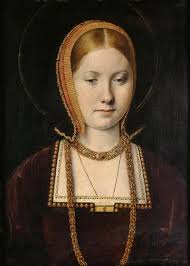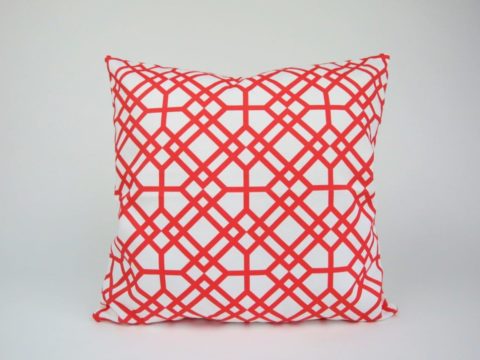The Influence of Henry VIII's Wives on Tudor Fashion Ideals
Chapter 2 : Katharine of Aragon

Katharine of Aragon married Henry VIII in 1509. Contemporary sources agree that Katharine was beautiful, with red gold hair and pale skin. The twenty-three-year old bride of the new king looked more like an English rose than a Spanish princess. Katharine had English ancestry on both sides of her family. She is named after Catherine of Lancaster, daughter of John of Gaunt and Constance of Castile, who married King Henry III of Castile in 1388.
Katharine and Henry were crowned in a joint ceremony on 22 June, 1509, the only joint coronation of the Tudor dynasty. According to the chronicler Hall, ‘her persone appareled in white Satyn Embrodered, her heire hangyng doune to her back, of a very great length, beautiful and goodly to behold.”
According to historic costumier Ninya Mikhaila, when Katharine arrived in England wearing Spanish fashions including a farthingale, she was quick to abandon them and adopt the fashions of her new country. The farthingale did not gain in popularity until the reign of her daughter, Mary I. Katharine did occasionally return to Spanish clothing, but only when they served a political or personal purpose. For example, when she and Henry met Charles V at Canterbury in 1520, she complimented her husband in an English dress of cloth of gold and pearls, but flattered Charles and reminded him of family ties by wearing a Spanish headdress. She also used her clothing to express her displeasure, such as at the Field of Cloth of Gold in 1520, when she wore Spanish clothing in protest of the French alliance.
Katharine’s wardrobe accounts show that her primary colour for garments was black, followed by purple and crimson, mainly in the fabrics of velvet, satin and tilsent. Katharine is well known for wearing mainly gabled hoods. However, a portrait from the late fifteenth or early sixteenth century by Michael Sittow shows the young Katharine wearing a version of a French hood, and her household records show the queen purchased one for her daughter, Mary.
Thomas More had written of Katharine “there is nothing wanting in her that the most beautiful girl should have.” Tragically, although conceiving many times, she had only one surviving child, her daughter, Princess Mary.
By 1518, Henry VIII began one of the most significant affairs of his life. Elizabeth, or Bessie, Blount was a maid of honour for Queen Katharine. Bessie was said to be one of the most beautiful ladies at court, with blonde hair, a fair complexion and blue eyes. Chronicler Edward Hall wrote in 1518 that Henry was ‘in the chains of love with her.” In late spring 1519 she gave birth to Henry VIII’s first son to survive infancy, Henry Fitzroy. Carvings on the tomb of Bessie’s parents show each of their children, including Bessie. Each child’s face is different, which suggests these carvings were true to their likeness. The carving, identified by Elizabeth Norton, shows a woman with an elegantly long nose and small, plump lips wearing a gabled hood.
Another well-known royal mistress during this time was Mary Boleyn, sister of Henry’s future wife, Anne Boleyn. Not much is known about Henry and Mary’s relationship, but some historians believe Mary’s daughter, Catherine Carey, was Henry’s second illegitimate child. It has been claimed that Mary had also been a mistress of King Francis I of France when she served at the court of his wife. Artist Remigius van Leemput painted Mary in the 1630’s, using her image from a now lost portrait by Hans Holbein the Younger. The van Leemput painting shows that Mary had large, golden-brown eyes, a round, plump face and small pink lips. She wears a gabled hood, so it is not possible to see her hair, but she was said to have light, fair hair.
Henry’s sister, Mary, who was Queen of France before marrying Charles Brandon to become the Duchess of Suffolk, was reportedly one of the greatest beauties of the time. The Venetian Ambassador wrote Mary was “very beautiful and has not her match in England; she is tall, fair, of light complexion with a colour and most affable and graceful.” A wedding portrait of the Duke and Duchess of Suffolk, attributed to Jan Gossaert in 1516, shows Mary in a sumptuous black velvet gown decorated with pearls and intricate gold embroidery on ornate sleeves. Her face is calm and serene, and very beautiful. Her hair appears rich brown, in addition to her eyes. She has a small, pink mouth, which was considered ideal at the time. Notably, Mary wears a French hood in the portrait, although Anne Boleyn, who did not arrive from France until 1522, is usually attributed with bringing the style to England.
